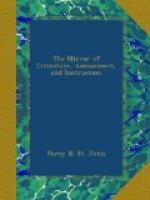We rode over to it: it is situated on a crag or ridge of rock, high in the north range of hills, the Lammer-muir, which spring from the splendid vale of Teviot and Tweed, commanding an unbounded prospect on the east and west; the south is terminated by the Cheviots and the English border.
We found the Tower in possession of a party, and the Rev. Mr. C—— rode forward to report, in case we should be deemed intruders. He came back shortly, and it was no other than Sir Walter himself, with several members of his family, who had accompanied him to bid a final farewell to Smaillum keep. As I afterwards heard, he was in the highest spirits, and repeated the poem for the gratification of his party, in that impressive manner for which he was remarkable, in giving the necessary effect to his own compositions. The party brought a cold collation with them: before leaving, Sir Walter surveyed the beautiful prospect at his feet, the Tweed and Teviot meeting in sisterly loveliness, and joining their waters in the valley, with the golden fields of England in the distance; when filling a glass of wine he drank with fervour, in which all joined him, “baith sides of the Tweed.”
I.
* * * * *
OLD ENGLISH ARMOUR.
(From a Correspondent.)
Previous to the time of Edward I., the body-armour may be distinguished by the appellations of trelliced, ringed, rustred, mascled, scalad, tegulated, single-mailed, and banded. The trelliced method has not been properly ascertained: it probably consisted of leather thongs, crossed, and so disposed as to form large squares placed angularly, with a round knob or stud in the centre of each. The ringed consisted of flat rings of steel, placed contiguous to each other, on quilted linen. The rustred was nothing more than one row of flat rings, about double the size of those before used, laid half over the other, so that two in the upper partially covered one below. Mascled; the hauberk composed of several folds of linen, covered with diamond-shaped pieces of steel touching each other, and perforated: so called from their resemblance to the meshes of a net. Scaled; formed of small pieces of steel like the scales of fish, partially overlaying each other. This species was used only during the reigns of Henry II and Richard I. The tegulated consisted of little square plates, partly covering one another, like tiles.
Single Mail was composed of rings set edgeways on quilted linen. It came into use about the close of John’s reign, and continued to be partially worn till that of Edward I. At the commencement of Henry III.’s reign, it covered not only the head, but hands, legs, and feet. It was very heavy, and likewise the rings were liable to be cut off by the blow of a sword; which latter circumstance, perhaps, introduced the contrivance of banded armour, which was composed of parallelogramic pieces of metal, sown on linen, so placed as to fold perpendicularly over each other, like palings, and kept in their places by bandy or hoops of leather.




